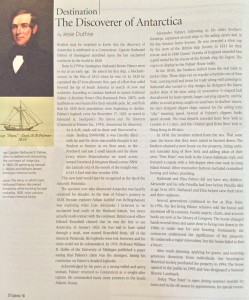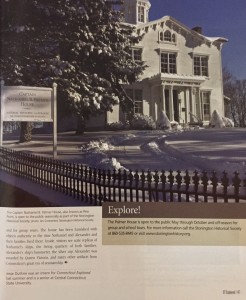By Jesse Duthrie (c) Connecticut Explored, Winter 2011/2012
 Readers may be surprised to know that the discovery of Antarctica is attributed to a Connectican. Captain Nathaniel Palmer of Stonington stumbled upon the last uncharted continent in the world in 1820.
Readers may be surprised to know that the discovery of Antarctica is attributed to a Connectican. Captain Nathaniel Palmer of Stonington stumbled upon the last uncharted continent in the world in 1820.
Born in 1799 in Stonington, Nathaniel Brown Palmer went to sea at an early age. He joined his first ship, a blockade-runner, in the War of 1812 when he was 14. In 1820 he captained the 47-foot schooner Hero, part of a fleet that sailed beyond the tip of South America in search of new seal rookeries. According to Candace Sanford in Captain Nathaniel Palmer: A Maritime Pioneer (Flat Hammock Press, 2007), seals had been so over-hunted for their valuable pelts, fat, and flesh that by 1820 their populations were beginning to decline. Palmer’s logbook entry for November 17, 1820, as noted in Edouard A. Stackpole’s The Huron and The Huntress (Connecticut Printers Inc., 1955), documents his discovery:
At 4 A.M. made sail in shore and Discovered-a-strait- Tending SSW&NNE it was Literally filled with Ice and the shore inaccessible thought it not Prudent to Venture in we Bore away to the Northw’d and saw 2 small Islands and the shore every where Perpendicular we stood across toward Freseland [Livingston Island] course NNW the Latitude [sic]of the mouth of the straight was 63.45 S End with fine weather SSW.
This new land would later be recognized as the tip of the Antarctic Peninsula.
The question over who discovered Antarctica was heavily contested for decades. At the time of Palmer’s journey in 1820, Russian explorer Fabian Gottlief von Bellingshausen was exploring what Czar Alexander I believed to be uncharted land south of the Shetland Islands, but never actually made contact with the continent. British naval officer Edward Bransfield claimed that he was the first to see Antarctica, in January 1820. He was said to have sailed through a strait, now named Bransfield Strait, off of the Antarctic Peninsula. His logbooks were lost, however, and his claim could not be substantiated. In 1939, Professor William H. Hobbs of the University of Michigan published a paper stating that Palmer’s claim was the strongest, basing his conclusion on Palmer’s detailed logbooks.
Acknowledged by his peers as a strong-willed and savvy seaman, Palmer returned to Connecticut as a sought-after captain. He commanded many more journeys to the South Atlantic Ocean.
Alexander, following in his older brother’s footsteps, captained several ships in his sailing career and, in his day, became better known. He was awarded a silver cup by the crew of the British ship Dorothy in 1833 for their rescue, and in 1840 Queen Victoria of England awarded him a gold medal for his rescue of the British ship the Eugene. The cup is on display in the Palmer House today.
In the 1830s, the brothers shifted from the seal trade to packet ships. These ships ran on regular schedules out of New York carrying mail and items for trade along with passengers. Nathaniel also turned to ship design; he designed the fastest packet ships of his time using an innovative U-shaped hull that allowed for faster speeds, larger carrying capacity, and the ability to avoid getting caught on sand bars in shallow waters. He later designed clipper ships, named for the sailing term “clip,” meaning speed. Several of Palmer’s clippers broke speed records: The Great Republic traveled from New York to London in 12 days, and the Oriental sped from New York to Hong Kong in 80 days.
In 1850, the brothers retired from the sea. That same year, the house that they were raised in burned down. The brothers planned a new house on the property, hiring architect Gamaliel King of New York and adding ideas of their own. “Pine Point” was built in the Greco-Italianate style and featured a cupola with a 360-degree view that took in Long Island Sound. Other innovative features included centralized heating and indoor plumbing.
Nathaniel and Eliza Palmer did not have any children. Alexander and his wife Priscilla had four before Priscilla died at age 36 in 1851. Nathaniel and Eliza helped raise their niece and three nephews.
Several generations continued to live at Pine Point. In 1976, the last living Palmer relatives sold the house and auctioned off its contents. Family papers, charts, and account books are now at the Library of Congress. The house changed hands several times and came close to being torn down in the 1980s to make way for new housing. Fortunately, the contractor understood the significance of the property. He undertook a major renovation, but the house failed to find a buyer.
After much planning, applying for grants, and receiving generous donations from individuals, the Stonington Historical Society purchased the property in 1994. The house opened to the public in 1995 and was designated a National Historic Landmark.
Today ”Pine Point” is open during summer months for tours and in the off-season by appointment, for special events, and for group tours. The house has been furnished with objects authentic to the time Nathaniel and Alexander and their families lived there. Inside, visitors see scale replicas of Nathaniel’s ships, the living quarters of both families, Alexander’s ship’s barometer, the silver cup Alexander was awarded by Queen Victoria, and many other artifacts from Connecticut’s great era of seamanship.
Jesse Duthrie was an intern for Connecticut Explored last summer and fall and is a senior at Central Connecticut State University.
Explore!
The Palmer House is open to the public May through October and off-season for group and school tours. For more information call the Stonington Historical Society, 860-535-8445 or visit www.stoningtonhistory.org.
Read more about Connecticut’s maritime history in the Spring 2009 issue.
